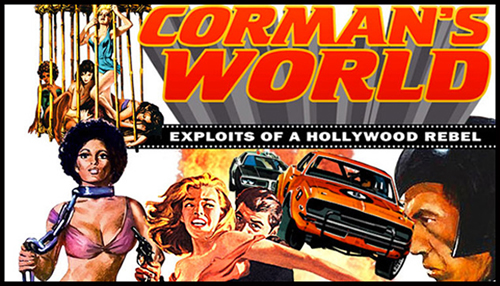"By mistake, he actually made a good picture once and awhile." -- Jack Nicholson, Corman's World: Exploits of a Hollywood Rebel
"Taste was out of the question." -- Martin Scorsese, Corman's World: Exploits of a Hollywood Rebel
Cinema Trash filmmaking is an art form--seriously, it is-- and its greatest ideologist and practicioner is Roger Corman. He didn't invent cheap sensational movies, but he knew how to make them highly profitable and when to kick-start a trend or exploit it to sell more theater seats (or drive-in car slots). Soft-spoken but craftily articulate, Corman is the star of Alex Stapleton's no frills documentary, Corman's World: Exploits of a Hollywood Rebel, which highlights how Corman ignited the careers of actors and directors who embraced--more like succumbed to, really--his pragmatic, and unwavering, bottom-line focused, moviemaking eye.
I first became acquainted with Corman's work through The Terror, a movie whose inexplicable mix of budget-friendly moments and left-over sets went unnoticed by my 7-year-old eyes as I ruined my parents night out. I couldn't help it. I refused to stay home with the babysitter so they had to take me along to the Loew's Oriental theater (this was in Brooklyn). I quietly sat between them as I watched Jack Nicholson, Dick Miller, Boris Karloff, and Sandra Knight chew up the gothic scenery, not really understanding what was happening. Of course, after the five or so directors got through with it, no one else did, either. I'm sure I had hit up the concession stand for treats, but I don't remember what I ate. What I do remember is that scene: Helene (Sandra Knight) melting away into brown goo after Andre (Jack Nicholson) rescues her. That I remember. I blame Corman for hooking me on horror movies because The Terror is the first one I saw on the big screen (or small, for that matter).
My father isn't much into horror movies, but my mom was. I'm sure she had forced him to see The Terror. What my dad did like back then were biker movies, so the next memorable Corman movie for me was seen at a New Jersey drive-in. It was on a double bill (maybe triple, actually) that I saw The Wild Angels and Richard Rush's Hells Angels on Wheels (starring Jack Nicholson). I peetered out by the time the third movie started playing so we headed home. My dad forgot to unhitch the speaker from the car's window, so we took that home, too.
Biker movies always scared me more than the supernatural and monster ones. The odds of being beat up by a biker (my nose was broken by one) were greater than being attacked by a giant, head-eating crab with googly eyes or a giant plant noshing on my body parts. Between the bikers, the seafood, and the florist, Corman's cinema world percolates with its roughness, exploitation, hipness, and edgy cheapness, and all of this is revealed by Stapleton through movie clips, Corman's own words, and words from the notable creative people who brought us these independent--in attitude as well as production--movies.
Stapleton shows us the lean, iconoclastic, must-not-deviate-from-plan Corman machine with its output spanning nearly every genre: western, gangster, science fiction, horror, teenage angst, biker, psychedelic, and social commentary with his more daring--AIP didnt' want it, so he produced it himself--The Intruder, which starred William Shatner. For horror fans, it's the Poe cycle of the 1960s, with Vincent Price, that makes Corman a household name. House of Usher, Masque of the Red Death, The Raven (with Boris Karloff and Peter Lorre), The Haunted Palace (actually taken from H.P. Lovecraft's The Case of Charles Dexter Ward), The Pit and the Pendulum, and The Premature Burial (starring Ray Milland and Hazel Court instead of Price) are atmospheric. Aided by recognizable actors and stylish use (and re-use) of sets, costumes, and storylines, they remain clear examples of how artistic expression and commercial success can be achieved on a shoestring budget.
The Raven's sets, when Corman realized he had a few days left on the shooting schedule before they would be torn down, were used in The Terror. In turn, Peter Bogdanovich, who cut his teeth for Corman with Voyage to the Planet of Prehistoric Women, would utilize footage of The Terror in Targets, his disturbing movie that highlights the demarcation line between the old style monsters of Universal Studios and the new, socially misfitted, psycho-killing monster living next door. (See my review: Targets: Is This What I Was Afraid Of?)
Bogdanovich had to use Boris Karloff in Targets because Karloff owed Corman a few days work, and Corman also insisted some twenty minutes of scenes from The Terror be incorporated by Bogdanovich (but in the final tally it was only a few). Given these requirements, Bogdanovich and Samuel Fuller wrote the screenplay, resulting in a movie that transcends its limitations by embracing them, making it a must-see movie for every horror fan as it presages the reality-terrors of the 1970s. It also earned a place in 1001 Movies You Must See Before You Die.
I don't know how Stapleton coaxed the usually laconic Jack Nicholson to talk about his years with Corman, but he opens up in a way that invigorates this documentary through his simplicity and directness about the relationship. At one point Nicholson cries when he realizes how much his career gained by falling under Corman's spell. Film clips keep the documentary lively, while an on location shoot with Corman for Dinoshark provides a glimpse of him in action.
Like Svengali, Corman mesmerizes those who work under him into squeezing their talents through his production funnel to produce usually awful, often memorably awful, and sometimes even noteworthy movies. No drive-in needed.




Comments